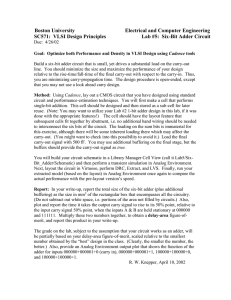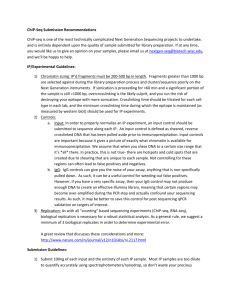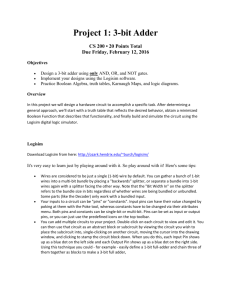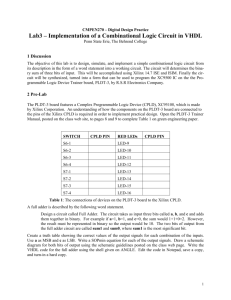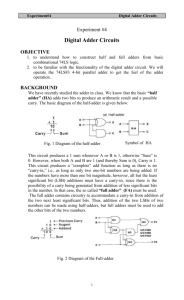z x1
advertisement
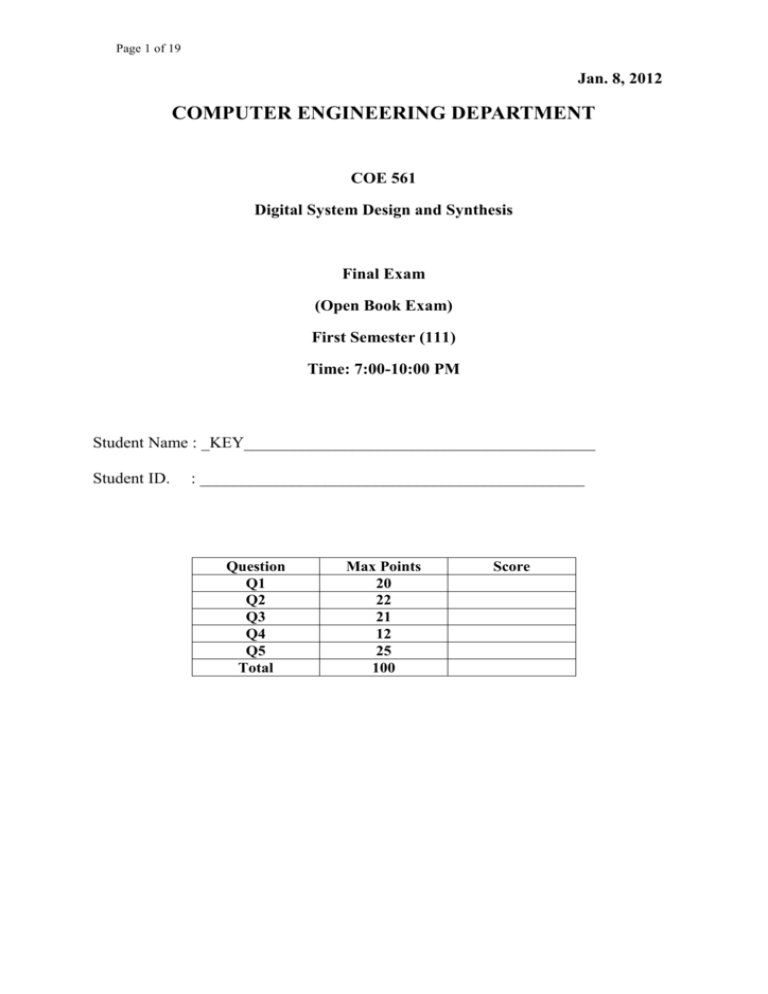
Page 1 of 19
Jan. 8, 2012
COMPUTER ENGINEERING DEPARTMENT
COE 561
Digital System Design and Synthesis
Final Exam
(Open Book Exam)
First Semester (111)
Time: 7:00-10:00 PM
Student Name : _KEY__________________________________________
Student ID.
: ______________________________________________
Question
Q1
Q2
Q3
Q4
Q5
Total
Max Points
20
22
21
12
25
100
Score
Page 2 of 19
[20 Points]
(Q1) Consider a technology library containing the following cells:
Cell
Area Cost
INV(x1) = x1’
1
NAND2(x1, x2) = (x1 x2)’
2
NAND3(x1, x2, x3) = (x1 x2 x3)’
3
NOR2(x1, x2) = (x1 + x2)’
2
NOR3(x1, x2, x3) = (x1 + x2 + x3)’
3
AOI21(x1, x2, x3) = ((x1 x2) + x3)’
3
AOI22(x1, x2, x3, x4) = ((x1 x2) + (x3 x4))’
4
OAI21(x1, x2, x3) = ((x1+x2) x3)’
3
OAI22(x1, x2, x3, x4) = ((x1+x2) (x3+x4))’
4
Gate
Page 3 of 19
(i) Consider the circuit given below with inputs {a, b, c, d, e, f, g, h} and output {Z}.
Using the dynamic programming approach and Structural Matching, map the
circuit using the given library into the minimum area cost solution.
(ii) Can you obtain a better mapping than the one obtained in (i). If the answer is yes,
show the better solution and explain how it is obtained.
(iii) Assuming Boolean Matching, determine the number of ROBDD’s that need to be
stored in the cell library for the following cell. Justify your answer.
Y = a b c d + a’ b’ c d + e f + e’ g
Page 4 of 19
Page 5 of 19
Page 6 of 19
[22 Points]
(Q2) Consider the incompletely-specified FSM that has 5 states, one input (X) and one
outputs (Z), represented by the following state table:
Present State
S0
S1
S2
S3
S4
Next State, Z
X=0
X=1
S3, –
S0, –
S4, 0
S0, –
S3, 0
S1, –
S2, –
S2, –
S2, 1
S1, –
(i)
Determine the incompatible states and the compatible states along with their
implied pairs.
(ii)
Compute the maximal compatible classes along with their implied state pairs.
(iii)
Compute the prime compatibility classes along with their implied state pairs.
(iv)
Reduce the state table into the minimum number of states and show the reduced
state table.
Page 7 of 19
Page 8 of 19
Page 9 of 19
[21 Points]
(Q3) Consider the given FSM which has 4 states, one input and one output, represented by
the following state table:
Product
P1
P2
P3
P4
P5
P6
P7
P8
(i)
Input
0
1
0
1
0
1
0
1
Next State
S2
S2
S2
S3
S4
S3
S4
S1
Output
0
0
0
0
0
0
0
1
Assuming the following constraints: S3 covers S2, and that the code of S4 is
covered by all other state codes, the state table can be reduced into the table given
below. Using implicant merging and covering relations show step by step how you
can obtain the reduced state stable given below:
Input
–
1
1
(ii)
Present State
S1
S1
S2
S2
S3
S3
S4
S4
Present State
S1, S2
S2, S3
S4
Next State
S2
S3
S1
Output
0
0
1
Compute all the seed dichotomies and construct their compatibility graph. Find a
minimum cover for the seed dichotomies. Based on the found cover, derive an
encoding satisfying the given constraints with minimal bit length.
Page 10 of 19
Page 11 of 19
Page 12 of 19
[12 Points]
(Q4) Consider the sequential circuit given below having 3 inputs {A, B, C} and one output
{Z}. Assume that the delay of all given gates is 2 unit delays.
(i)
Determine the critical path of this circuit and the maximum propagation delay.
(ii)
Using only the Retiming transformation, reduce the critical path of this circuit
with the minimum number of flip-flops possible. Determine the maximum
propagation delay after retiming.
Page 13 of 19
Page 14 of 19
[25 Points]
(Q5) Consider the network given below with inputs {i1, i2, i3, i4, i5, i6, i7, i8, i9, i10, i11}
and outputs {o1, o2, o3}. Assume that the delay of both the Adder and the Multiplier fit
within one clock cycle and that the input values will be available to the circuit for only one
clock cycle. Also assume that both addition and subtraction operations will be performed by
the Adder.
a = i1 + i2;
b = a – i3;
c = i4 + i5;
d = i7 * i8;
e = i9 + i10;
f = d + e;
g = i11 * 7;
o1= b * 3;
o2 = c + i6;
o3= g * f;
(i)
Using List Scheduling algorithm LIST_L, schedule the sequencing graph into the
minimum number of cycles under the resource constraints of one Adder and one
Multiplier. Show the details of the algorithm step by step and the resulting
scheduled sequencing graph.
(ii)
Using List Scheduling for minimum resource usage algorithm LIST_R, schedule
the sequencing graph under the latency constraint of 5 clock cycles minimizing the
number of resources required. Show the details of the algorithm step by step and
the resulting scheduled sequencing graph.
(iii)
Consider the scheduled sequencing graph below:
a. Show the life-time of all variables.
b. Determine the minimum number of registers that are required to store all
the variables. Show the mapping of variables to registers. Select a mapping
that minimizes the number of multiplexers and interconnect area as
much as possible.
c. Draw the data-path implementing the scheduled sequencing graph based
on the variable-register mapping that you obtained in (b).
Page 15 of 19
Page 16 of 19
Page 17 of 19
Page 18 of 19
Page 19 of 19




